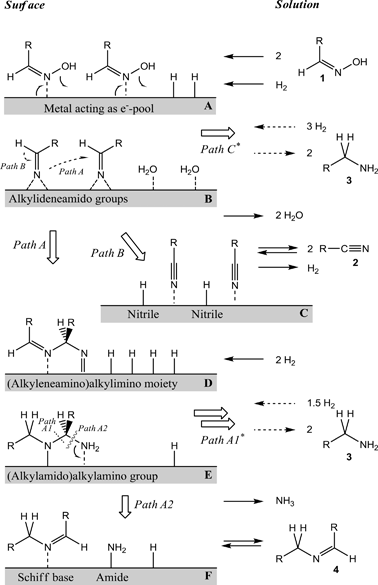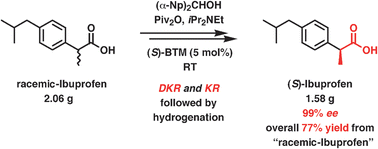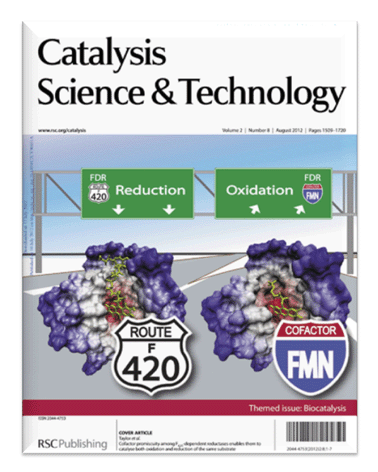 |
Looking back over our first year’s worth of articles, we are delighted with the high quality work being published by our authors.
Here are the articles that you are citing the most so far*…
|
Top cited Reviews
Challenge and progress: palladium-catalyzed sp3 C–H activation
Hu Li, Bi-Jie Li and Zhang-Jie Shi
Catal. Sci. Technol., 2011, 1, 191-206
Two-dimensional zeolites: dream or reality?
Wieslaw J. Roth and Jiří Čejka
Catal. Sci. Technol., 2011, 1, 43-53
Superparamagnetic nanoparticles for asymmetric catalysis—a perfect match
Kalluri V. S. Ranganath and Frank Glorius
Catal. Sci. Technol., 2011, 1, 13-22
Well-defined copper(I) complexes for Click azide–alkyne cycloaddition reactions: one Click beyond
Silvia Díez-González
Catal. Sci. Technol., 2011, 1, 166-178
Metal–organic frameworks as heterogeneous catalysts for oxidation reactions
Amarajothi Dhakshinamoorthy, Mercedes Alvaro and Hermenegildo Garcia
Catal. Sci. Technol., 2011, 1, 856-867
Chemocatalytic conversion of cellulose: opportunities, advances and pitfalls
Jan A. Geboers, Stijn Van de Vyver, Roselinde Ooms, Beau Op de Beeck, Pierre A. Jacobs and Bert F. Sels
Catal. Sci. Technol., 2011, 1, 714-726
 Recent advances in asymmetric catalysis with cinchona alkaloid-based primary amines
Recent advances in asymmetric catalysis with cinchona alkaloid-based primary amines
Lin Jiang and Ying-Chun Chen
Catal. Sci. Technol., 2011, 1, 354-365
A review of the development of nitrogen-modified carbon-based catalysts for oxygen reduction at USC
Gang Liu, Xuguang Li, Jong-Won Lee and Branko N. Popov
Catal. Sci. Technol., 2011, 1, 207-217
Towards near zero-sulfur liquid fuels: a perspective review
Barbara Pawelec, Rufino M. Navarro, José Miguel Campos-Martin and José L. G. Fierro
Catal. Sci. Technol., 2011, 1, 23-42
Design of hierarchical zeolite catalysts by desilication
Danny Verboekend and Javier Pérez-Ramírez
Catal. Sci. Technol., 2011, 1, 879-890
Top cited articles
Synthesis, characterization and ethylene oligomerization behaviour of 8-(1-aryliminoethylidene)quinaldinylnickel dihalides
Shengju Song, Tianpengfei Xiao, Tongling Liang, Fosong Wang, Carl Redshaw and Wen-Hua Sun
Catal. Sci. Technol., 2011, 1, 69-75
Microwave-assisted synthesis of ZnO–graphene composite for photocatalytic reduction of Cr(VI)
Xinjuan Liu, Likun Pan, Tian Lv, Ting Lu, Guang Zhu, Zhuo Sun and Changqing Sun
Catal. Sci. Technol., 2011, 1, 1189-1193
A straightforward zinc-catalysed reduction of sulfoxides to sulfides
Stephan Enthaler
Catal. Sci. Technol., 2011, 1, 104-110
Activity improvement of gold yolk–shell catalysts for CO oxidation by doping with TiO2
Robert Güttel, Michael Paul and Ferdi Schüth
Catal. Sci. Technol., 2011, 1, 65-68
In situ green synthesis of Au nanostructures on graphene oxide and their application for catalytic reduction of 4-nitrophenol
Yingwei Zhang, Sen Liu, Wenbo Lu, Lei Wang, Jingqi Tian and Xuping Sun
Catal. Sci. Technol., 2011, 1, 1142-1144
SBA-15-Pr–SO3H as nanoreactor catalyzed oxidation of sulfides into sulfoxides
Kiumars Bahrami, Mohammad M. Khodaei and Peyman Fattahpour
Catal. Sci. Technol., 2011, 1, 389-393
Synthesis and characterization of versatile MgO–ZrO2 mixed metal oxide nanoparticles and their applications
Manoj B. Gawande, Paula S. Branco, Kalpesh Parghi, Janhavi J. Shrikhande, Rajesh Kumar Pandey, C. A. A. Ghumman, N. Bundaleski, O. M. N. D. Teodoro and Radha V. Jayaram
Catal. Sci. Technol., 2011, 1, 1653-1664
Gold(I)-catalyzed synthesis of furans and pyrroles via alkyne hydration
Pierrick Nun, Stéphanie Dupuy, Sylvain Gaillard, Albert Poater, Luigi Cavallo and Steven P. Nolan
Catal. Sci. Technol., 2011, 1, 58-61
Fabrication of a TiO2 nanoparticles impregnated titanium mesh filter and its application for environmental purification
Tsuyoshi Ochiai, Toru Hoshi, Houda Slimen, Kazuya Nakata, Taketoshi Murakami, Hiro Tatejima, Yoshihiro Koide, Ammar Houas, Takuji Horie, Yuko Morito and Akira Fujishima
Catal. Sci. Technol., 2011, 1, 1324-1327
2-(1-Aryliminopropylidene)quinolylcobalt(II) dichlorides: synthesis, characterization and catalytic behaviour towards ethylene
Tianpengfei Xiao, Jingjuan Lai, Shu Zhang, Xiang Hao and Wen-Hua Sun
Catal. Sci. Technol., 2011, 1, 462-469
Selective oxidation of biorenewable glycerol with molecular oxygen over Cu-containing layered double hydroxide-based catalysts
Chun-Hui Zhou, Jorge N. Beltramini, Chun-Xiang Lin, Zhi-Ping Xu, G. Q. (Max) Lu and A. Tanksale
Catal. Sci. Technol., 2011, 1, 111-122
Why not have a look at some of our other article collections?
Monthly top-accessed content
Reviews in catalysis
Outstanding organocatalysis
Zeal for zeolites
Incredible ionic liquids

*(Thomson Reuters®)
Comments Off on The cream of catalysis – top cited articles of 2011
 Perhaps the most well-known applications of organometallics in catalysis are the Ziegler–Natta catalysts which are used to generate polymers, the catalysts are made up of mixtures of transition metal halides and organo-aluminium complexes. Karl Ziegler and Giulio Natta were awarded the 1963 Nobel Prize in Chemistry for their discovery and development of the catalysts, which today are the most commonly used for the manufacture of polythene.
Perhaps the most well-known applications of organometallics in catalysis are the Ziegler–Natta catalysts which are used to generate polymers, the catalysts are made up of mixtures of transition metal halides and organo-aluminium complexes. Karl Ziegler and Giulio Natta were awarded the 1963 Nobel Prize in Chemistry for their discovery and development of the catalysts, which today are the most commonly used for the manufacture of polythene.






















